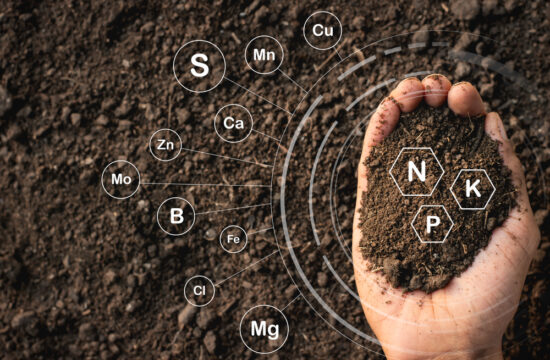Plants require a spectrum of essential nutrients to achieve optimum growth and yield. Vital nutrients fuel various physiological processes in plants, from root development to flowering and fruit production, and understanding these nutrients is the key to cultivating robust crops.
Each plant nutrient serves a specific function, and its deficiency can lead to reduced crop health and yield. Whether you manage vast fields or small-scale farms, this guide will equip you with the knowledge to ensure your crops get the nourishment they need.
What are Essential Plant Nutrients?
Just like humans need a balanced diet to thrive, plants also require a mix of essential nutrients for optimal growth, development, and yield. These nutrients are critical to various physiological processes, from root development to flowering and fruit production.
Plants primarily draw these nutrients from the soil, with each nutrient serving a unique purpose. Nutrient deficiencies typically lead to poor plant health and decreased yields. Understanding these essentials is key to cultivating healthy and vigorous plants.
There are two categories of essential plant nutrients: macronutrients and micronutrients.
Essential Macronutrients for Plant Growth
Macronutrients are needed by plants in larger quantities and include:
- Nitrogen (N): Vital for leaf growth and the production of chlorophyll, the pigment responsible for photosynthesis. It promotes vigorous vegetative growth and enhances the plant’s ability to produce proteins, enzymes, and nucleic acids.
- Phosphorus (P): Crucial for energy transfer within the plant, phosphorus supports root development, flowering, and fruit production. It is a key component of ATP (adenosine triphosphate), which fuels various biochemical processes, including photosynthesis and respiration.
- Potassium (K): Essential for regulating water uptake and movement within the plant. It helps improve drought resistance, disease resistance, and overall plant health by activating enzymes involved in photosynthesis and protein synthesis.
- Calcium (Ca): Important for the structural integrity of cell walls and membranes. Calcium helps maintain cell stability, supports root and shoot growth, and is involved in signaling pathways that regulate various physiological processes.
- Magnesium (Mg): A central component of chlorophyll, which is essential for photosynthesis. Magnesium also helps activate enzymes involved in carbohydrate and protein metabolism, contributing to overall plant health and productivity.
- Sulfur (S): Necessary for the synthesis of certain amino acids and proteins, sulfur is involved in the formation of essential oils and vitamins. It also plays a role in enzyme function and chlorophyll production, supporting healthy plant growth.
Essential Micronutrients for Plant Growth
Micronutrients, needed by plants in smaller quantities, include:
- Boron (B): Essential for cell wall formation and the development of new growth. It also aids in the transport of sugars and energy within the plant.
- Chlorine (Cl): Important for photosynthesis and osmoregulation. It helps in maintaining proper ion balance and is crucial for stomatal function.
- Copper (Cu): Plays a key role in photosynthesis, respiration, and the formation of lignin in plant cell walls. It also acts as a catalyst in various enzymatic reactions.
- Iron (Fe): Vital for chlorophyll production and photosynthesis. It is a critical component of several enzymes involved in energy transfer and electron transport.
- Manganese (Mn): Involved in photosynthesis, respiration, and nitrogen assimilation. It helps activate enzymes responsible for various metabolic processes.
- Molybdenum (Mo): Essential for nitrogen fixation and the conversion of nitrate to ammonium in plants. It also aids in the synthesis of certain proteins and enzymes.
- Zinc (Zn): Important for enzyme function, protein synthesis, and growth regulation. It supports the production of auxins, which are plant hormones essential for growth.
The Dangers of Plant Nutrient Imbalances
Nutrient deficiencies in plants can lead to numerous problems that hinder their growth and development. When plants lack essential nutrients, they often exhibit various visible symptoms. For example, phosphorus deficiency can result in stunted growth and dark green foliage, while potassium deficiency often leads to leaf edge browning and curling.
Conversely, an excess of essential plant nutrients can be just as detrimental as a deficiency. Over-fertilization can lead to nutrient toxicity and reduce their ability to absorb water and nutrients effectively. This situation often manifests as burnt or scorched leaves, stunted growth, or plant death. For example, too much nitrogen can lead to excessive leaf growth at the expense of fruit or flower development.
Conducting a soil test is crucial to avoiding these essential plant nutrient pitfalls. Soil testing reveals the nutrient composition of your soil, allowing you to understand what your plants are receiving and lacking. Regular soil testing can aid in ensuring that your plants get a suitable amount of nutrients without over-fertilizing them. Regular soil testing, especially before planting and at regular intervals during the growing season, is a proactive approach that saves time and resources and ensures the health and vitality of your plants.
Essential Plant Nutrient Case Study: Nitrogen
Nitrogen plays a central role in several key growth processes for plants. It is a major component of chlorophyll and is critical for synthesizing proteins. These proteins are instrumental in developing plant tissues, including leaves, stems, and roots. Nitrogen is also a part of amino acids, enzymes, and even plant DNA.
However, nitrogen deficiency can significantly impact plant health and growth. Symptoms of this deficiency are often most visible in the older leaves, as nitrogen is a mobile nutrient within the plant. These older leaves may turn yellow or light green because the plant transfers its limited nitrogen supply to support new growth.
Other signs include stunted growth, weak stem development, and a general reduction in vigor and yield. Nitrogen-deficient plants struggle to carry out photosynthesis effectively, leading to reduced energy production and limited growth and development.
Correcting a nitrogen deficiency in your plants involves careful management and application of nitrogen fertilizers. There are various types of nitrogenous fertilizers and enhancers available, such as urea, ammonium nitrate, and ammonium sulfate, each with its application methods and efficacy. They also come in both granular and liquid forms.
Organic options like blood meal or composted manure are also effective and can improve soil health in addition to providing nitrogen. However, it’s crucial to manage nitrogen fertilizer application correctly. Over-application can lead to nitrogen runoff, which can harm nearby aquatic ecosystems.
It’s also important to consider the plant’s growth stage and the existing soil nitrogen levels, often determined through soil testing, to apply the correct amount of fertilizer. Regular monitoring and soil testing can guide timely and appropriate nitrogen applications, ensuring that plants receive the optimal amount for their growth needs.
Optimize Your Nitrogen Usage for Plant Growth
Ensure your nitrogen works harder and stays longer in the soil with NutriSphere-N®. Experience proven performance with a 3-to-1 ROI. Try NutriSphere-N Now!
How to Identify & Correct Plant Nutrient Deficiencies
Identifying and correcting plant nutrient deficiencies can be a nuanced process. Here’s a step-by-step guide to help you diagnose and address these issues effectively:
- Observe Plant Symptoms: Look for common signs of nutrient deficiencies. Yellowing leaves, stunted growth, and weak stem development are general indicators.
- Consider the Nutrient’s Role: Understanding the role of different nutrients can help in diagnosis. Iron deficiency, for instance, leads to yellowing between the veins of new leaves, while manganese deficiency causes older leaves to yellow.
- Soil Testing: Conduct a soil test to determine the exact nutrient composition of your soil. This step is crucial as it provides concrete data on which nutrients are lacking and guides you in making accurate corrections.
- Adjust Fertilization: Based on soil test results, adjust your fertilization practices. Apply specific fertilizers targeting the deficient nutrients for micronutrient deficiencies. For phosphorus management, consider using a phosphorus fertilizer enhancer. Remember, too much of a nutrient can be as harmful as too little.
- Monitor Plant Response: After applying the necessary corrections, monitor your plants over the following weeks to see how they respond. Improvements in color, growth, and overall health indicate a successful correction.
- Prevent Future Deficiencies: Implement regular soil testing and balanced fertilization practices to prevent future nutrient deficiencies.
- Seek Expert Plant Nutrient Advice: If problems persist, seeking advice from a local agricultural extension office or a plant expert can be very helpful.
The Importance of Balanced Nutrition for Plant Growth
Just like humans, plants require a variety of nutrients in specific amounts to thrive. Deficiencies in key nutrients like nitrogen, phosphorus, or potassium can stunt growth, reduce yields, and leave plants more susceptible to disease. Conversely, excesses can cause toxicity, waste resources, and disrupt the delicate balance of soil health.
A comprehensive nutrient management strategy ensures that crops receive the right nutrients at the right time and in the right quantities. By understanding each crop’s specific needs and leveraging advanced solutions like Verdesian’s nutrient efficiency technologies, growers can effectively address deficiencies and excesses. The result? Healthier plants, higher yields, and a more sustainable approach to agriculture.
The Role of Water, Air, and Soil in Plant Growth
- Explain how water and carbon dioxide are essential for photosynthesis, the process by which plants create energy (glucose) and oxygen.
- Discuss the role of water in nutrient transport, temperature regulation, and plant hydration.
- Highlight the role of carbon dioxide in energy production and the impact of photosynthesis on life on Earth.
- Differentiate between nutrients from the soil (macronutrients and micronutrients) and those derived from air and water (carbon, oxygen, hydrogen).
Primary vs. Secondary Plant Nutrients
- Define the difference between primary and secondary nutrients (amount needed and role in plant health).
- Briefly explain primary nutrients (Nitrogen, Phosphorus, Potassium) and their core functions in plant growth.
- Highlight secondary nutrients (Calcium, Magnesium, Sulfur) and their supporting roles in plant structure and metabolism.
FAQs about Essential Plant Nutrients
What are the primary macronutrients for plants?
The primary macronutrients are nitrogen (N), phosphorus (P), and potassium (K). These are needed in relatively large quantities and play crucial roles in plant growth, such as promoting leaf development, root growth, and flowering.
What are the secondary macronutrients for plants?
Secondary macronutrients include calcium (Ca), magnesium (Mg), and sulfur (S). While they are required in smaller quantities compared to the primary macronutrients, they are still vital for overall plant health.
How can I determine if my plants have nutrient deficiencies?
Nutrient deficiencies can manifest as various symptoms, including yellowing or browning of leaves, stunted growth, poor flowering, or unusual leaf discoloration. Soil and plant tissue testing can help identify nutrient deficiencies accurately.
What are the best sources of essential plant nutrients?
Nutrient sources include organic matter (compost, manure), synthetic fertilizers, and naturally occurring minerals. The choice of nutrient source depends on the specific needs of your plants and the results of soil testing.
Can you over-fertilize plants with essential nutrients?
Yes, over-fertilizing can be harmful to plants. Excessive nutrient levels can lead to nutrient imbalances, damage to plant roots, and environmental pollution. It’s essential to follow recommended application rates and schedules.
How do I fertilize my plants properly?
Proper fertilization involves understanding your plant’s nutrient requirements, conducting soil tests, and following application guidelines on the fertilizer label. Applying the right nutrients in the right amounts at the right time is key.
Can plants take up nutrients from the air?
Some plants can absorb nutrients from the air, primarily carbon dioxide (CO2) and oxygen (O2). However, most essential nutrients are taken up by plants through their roots from the soil or growing medium.
What is the role of mycorrhizal fungi in nutrient uptake?
Mycorrhizal fungi form symbiotic relationships with plant roots and assist in nutrient uptake, particularly phosphorus. They increase the plant’s access to nutrients and can improve overall plant health.
Essential Plant Nutrients: Takeaways
Effective nutrient management is a foundational element of productive farming. Imbalances, including deficiencies or excesses, can significantly affect crop yield and quality. Regular soil testing, tailored fertilization practices, and vigilant monitoring are crucial to identifying and addressing these issues. For farmers, the journey to a bountiful harvest lies in carefully balancing these nutritional needs.
At Verdesian, we use the latest in agricultural science to enhance the health of crops. Our products are used in numerous crops to maximize yield, improve crop quality, increase nutrient availability, and much more. Contact us today for more information! If you’re ready to learn more about how you can improve your NUE, check out NUE University, our online learning platform designed to help those in agriculture learn about NUE practices and technology.


